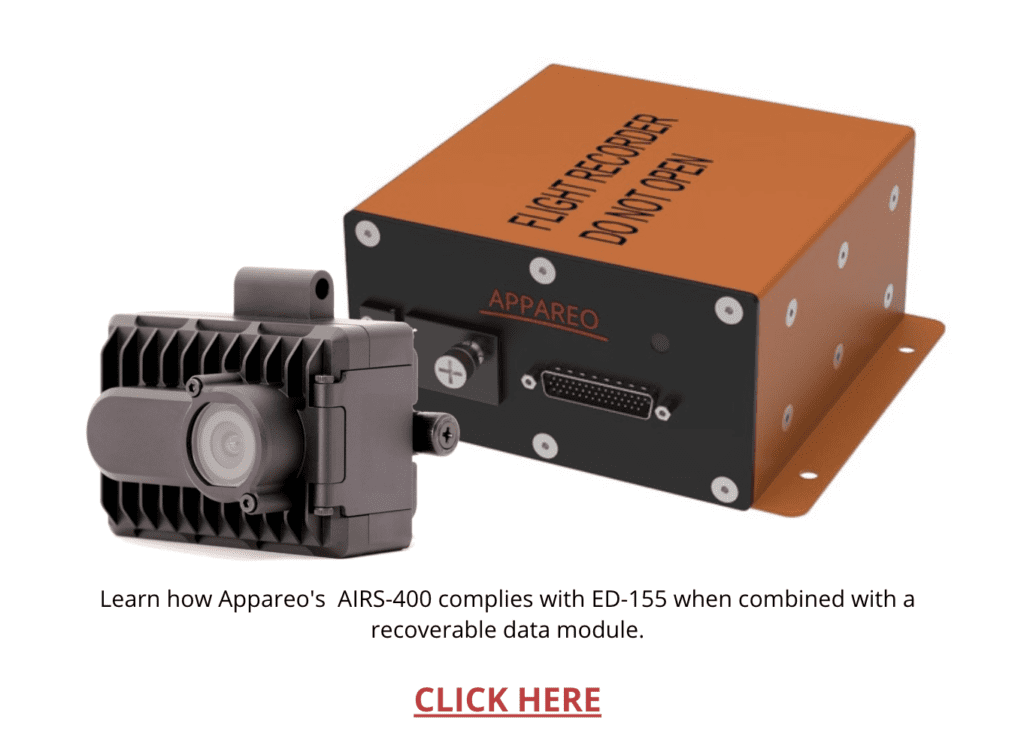Category Archives for Aviation
Artificial Intelligence Provides Great Opportunity for Off-Highway Equipment Industry

David Batcheller of Appareo recently sat down with OEM Off-Highway editor about the potential for Artificial Intelligence (AI) and augmented reality, as well as what challenges and opportunities lie ahead for the heavy equipment industries.
“AI has the potential to make decisions for operators,” says Batcheller. In the off-highway industry, using that capability can help to reduce the amount of training required for operators. Less experienced and well-trained operators can become more effective and more quickly become experts which can help to overcome the current labor shortages construction and other off-highway applications are facing.
You can read the article and watch the full video here: https://www.oemoffhighway.com/trends/video/21723061/ai-provides-great-opportunity-for-offhighway-equipment-industry
https://appareo.com/2021/10/27/artificial-intelligence-provides-great-opportunity-for-off-highway-equipment-industry/
Five Reasons Your Aircraft Needs Garmin Smart Glide
In the event of the loss of engine power in a single-engine aircraft, a pilot faces the urgent, workload-intensive job of maneuvering the aircraft from its current position to a suitable airport. Enter Garmin Smart Glide . Available on GTN
. Available on GTN Xi series navigators with compatible flight displays, Smart Glide provides added peace of mind, guidance and assistance during loss of power events in single-engine aircraft. Here are five ways Smart Glide can be helpful during these situations:
Xi series navigators with compatible flight displays, Smart Glide provides added peace of mind, guidance and assistance during loss of power events in single-engine aircraft. Here are five ways Smart Glide can be helpful during these situations:
1. It continuously calculates and assesses options in the background.
Engine-out emergencies can happen to anyone — anytime, anywhere — and those initial moments can be stressful. We designed Smart Glide to continually monitor flight conditions and calculate glide options in the background, so if a loss of engine power does occur, the system is already prepared. You can then activate Smart Glide in one of several easy ways depending on your avionics and panel configuration — with a dedicated panel-mounted Smart Glide button, by holding the Direct-to button on the GTN Xi navigator for two seconds or via a compatible flight display. This quick and easy activation allows pilots to continue assessing the situation, working through checklists and troubleshooting the issue.
2. It recommends a route with alternatives.
Once activated, Smart Glide automatically considers glide range, terrain, obstacles and more to recommend a suitable airport for landing, along with a list of alternative options in the vicinity (if available). If no airport is within the estimated glide range, Smart Glide will let you know.
Once an airport is selected, Smart Glide creates a Direct-to route to the airport.
3. It can assist flying a selected route.
If your aircraft is equipped with a Garmin GFC 500 or GFC
500 or GFC 600 autopilot, Smart Glide can lend a hand flying the plane. When activated, it automatically switches the CDI to GPS mode, engages the autopilot in IAS mode at best glide speed and activates flight director command bars on the compatible flight display. This allows pilots to dedicate more attention toward working through checklists and troubleshooting the emergency.
600 autopilot, Smart Glide can lend a hand flying the plane. When activated, it automatically switches the CDI to GPS mode, engages the autopilot in IAS mode at best glide speed and activates flight director command bars on the compatible flight display. This allows pilots to dedicate more attention toward working through checklists and troubleshooting the emergency.
For aircraft equipped with third-party autopilots, pilots can activate the appropriate autopilot modes to receive lateral GPS guidance with Smart Glide.
4. It automatically assists with certain emergency tasks.
To further assist pilots en route during a loss of engine power, Smart Glide automatically loads the selected airport’s CTAF frequency in the primary Comm standby position and offers a shortcut for loading transponder code 77001. That way, when the time comes to switch frequency or activate the emergency squawk code, Smart Glide has already prepared the avionics for the pilot
5. It automatically displays valuable information.
While en route to an emergency destination, Smart Glide displays a glide range ring and provides airport information, including bearing and distance, longest runway orientation, estimated arrival altitude (AGL) and winds (if available). The system also provides aural distance and bearing alerts for the airport and advises when the pilot should begin maneuvering for landing. Once the aircraft reaches that point, the pilot resumes control and can land the aircraft.
Are you ready to add Smart Glide to your aircraft? If your aircraft is already equipped with a compatible Garmin avionics, you may be able to add Smart Glide with a simple software upgrade — just contact your local Garmin authorized dealer. For more information about our Smart Glide technology and how it can be helpful during a loss of engine power, click here.
1Requires a compatible transponder (sold separately)
The post Five Reasons Your Aircraft Needs Garmin Smart Glide appeared first on Garmin Blog.
https://www.garmin.com/en-US/blog/aviation/five-reasons-your-aircraft-needs-garmin-smart-glide/
Four Reasons to Use AeroData in Your Flight Operations
Garmin announced the acquisition of AeroData, a leading provider of performance data solutions and services for commercial aircraft, in May 2021. With AeroData, operators benefit from countless features that make daily operations more seamless and help flights run safely and on time. And while the list is hard to narrow down, below are just a few of our favorite things about AeroData’s solutions.
1. Precision
With more than 30 years of experience, AeroData offers precise and accurate performance data to more than 70% of all airline flights in North America each day. Runway-specific departure engine failure procedures (EFPs) demonstrate obstacle clearance limits in an engine-out scenario for your specific aircraft airframe and engine model.
In addition to aircraft-specific EFPs, AeroData provides takeoff, en route and landing performance data; weight and balance; dvanced automated passenger and cargo load planning services, as well as many other integrated software solutions.
With AeroData, operators and crews have ultimate flexibility when conditions change quickly — contaminated runways, a sudden runway change, shifting winds, unexpected precipitation, and many more factors can drastically affect takeoff and landing performance data. Using AeroData, crews can quickly assess an intersection takeoff, alternate runway or account for changing containmated runway conditions — generally without the need to rerun calculations, easing cockpit workload and reducing dispatch displays.
2. Customization
Customer-defined parameters within AeroData provide ultimate flexibility and allow customers to tailor solutions to their engine/airframe combinations and operations. Because AeroData works with major airframe manufacturers, including Airbus, Boeing, Bombardier and Embraer, and most major flight planning systems, we can provide detailed performance data to any fleet and mix.
3. Ease of Use
Easily access performance data via an aircraft communication addressing and and reporting system (ACARS) connection. No ACARS? No problem. AeroData has multiple delivery methods, including a connected tablet option as well as a web-based platform to ensure important performance data is never far away. In addition, the AeroData performance solution offers primary delivery of performance data, as well as a backup service to help ensure flights are being dispatched consistently and on time. To provide an enhanced experience to the more than 135 airlines AeroData serves globally, the NOTAM and flight path analysis teams are available around the clock to help with any concerns.
4. Price
AeroData utilizes a shared cost model to ensure airlines both large and small can access the benefits of a real-time, connected performance data solution. The per-departure fee pricing allows operators greater budget accuracy and doesn’t penalize the airline during contractions. In addition, our vertical integration lowers setup fees and helps get your operation in the air even quicker.
Interested in learning more about AeroData? Contact a member of our team today.
The post Four Reasons to Use AeroData in Your Flight Operations appeared first on Garmin Blog.
https://www.garmin.com/en-US/blog/aviation/four-reasons-to-use-aerodata-in-your-flight-operations/
Garmin Avionics Team Wins 18th Consecutive Aviation International News Award
For the 18th year in a row, Aviation International News (AIN) has dubbed Garmin the Overall Average leader in the Flight Deck Avionics segment in the AIN 2021 Product Support Survey. Garmin also received top rankings in every category of the survey, which are: Cost Per Hour Programs, Parts Availability, Cost of Parts, AOG Response, Warranty Fulfillment, Technical Manuals, Technical Reps and Overall Avionics Reliability.
AIN’s annual Product Support Survey is based exclusively on feedback from users of business jets, pressurized turboprop airplanes and turbine-powered helicopters. The survey is password-protected to ensure that only qualified readers are able to give input — meaning the results are based on unbiased, professional opinions of 1,450 avionics systems evaluations.
In the past year, the Garmin avionics product support team has worked hard for the top ranking. Lee Moore, the Garmin director of avionics product support, reports that new projects include (but are certainly not limited to):
- The expansion of self-service opportunities with more video and frequently asked questions content if a customer prefers these options over direct phone or email support (both of which are still always available to those who prefer person-to-person interaction).
- The addition of staff to our customer support and distributor support teams, which allows for increased coverage during peak demand hours, more internal training options and expanded weekend operating hours.
- The automation of our field quality reporting process to expedite the flow of feedback directly from aircraft owner/operators, service centers and installers to the correct Garmin engineering team.
- The addition of virtual training offerings and a bolstered eLearning library so installers and pilots can continue to receive access to the best education even when pandemic restrictions hinder in-person training options.
To read AIN’s full survey report, click here. To contact our award-winning product support team or to access our library of eLearning materials, click here.
The post Garmin Avionics Team Wins 18th Consecutive Aviation International News Award appeared first on Garmin Blog.
https://www.garmin.com/en-US/blog/aviation/garmin-avionics-team-wins-18th-consecutive-aviation-international-news-award/
A Behind-the-scenes Look at Garmin Autopilot Certifications
Max Unruh’s official title at Garmin is aviation product manager of autopilot systems. In layman’s terms? He’s a part of the team that decides which aircraft to certify for Garmin autopilot solutions. That means he helps to determine which aircraft is up next for certification, as well as which model will be the ideal test aircraft. By his count, he’s completed about 54 aircraft contracts in his two years at Garmin, 40 of which were for the GFC 500 or GFC
500 or GFC 600 digital autopilot.
600 digital autopilot.
It’s a long process, says Unruh, and aircraft owners wait with baited breath as they refresh the list of currently supported aircraft, as well as those certification programs that are in progress and those that will begin in the next 12 months. But if you don’t see your aircraft included, don’t despair — there’s a way to toss your hat in the ring for your own plane, and Unruh is sharing some insight into the process for an extra edge.
What does Garmin look at when selecting a test aircraft?
Unruh looks for a unique combination of aircraft characteristics that tick all the boxes necessary for certification. “I have a high bar for incoming aircraft, and the selection process is not easy,” he says, noting that the owners who are selected typically report feeling like they’ve won the lottery. When he considers an individual aircraft, Unruh looks at:
- Aerodynamic characteristics of the airplane
- Horsepower
- Rating of the engine and common engine upgrades that are available out in the field
- The range of gross weight possible, from largest to smallest
- Whether the plane has any Garmin avionics installed already, particularly a display and GPS source at the minimum
How do I submit my aircraft for autopilot certification?
The answer to this one is simple: If you are interested in GFC 500 or GFC 600 for your aircraft, just fill out this form. And even if your plane isn’t chosen immediately, says Unruh, that doesn’t mean it’s not being considered.
“I go in and review that information,” says Max. “It’s personally reviewed by a Garmin employee. And when I am looking for an aircraft, I use that list heavily. That’s probably my best fishing hole.”
The form requests that you provide your name, email address, which autopilot model you’re interested in and your aircraft make, model and registration number. There’s also a section to include additional details, and this is where Unruh has some pro tips.
“The pertinent details are whether or not the aircraft has any mods that make it different from the type design or any type of damage history and modifications,” he says. “I really want to know what kind of Garmin avionics they have installed. And one really nice thing is when an owner puts down their phone number.”
Another pro tip? If you’re connected with owners of similar aircraft, have them submit theirs for consideration as well.
“I like when owner groups post their aircraft on our website en masse,” says Unruh. “It generally helps to have a passionate and engaged aircraft owners group!”
What does the autopilot certification process look like once an aircraft is selected?
Once an aircraft is selected for autopilot testing and a contract is executed, the aircraft is flown to a Garmin facility and thoroughly inspected. The Garmin mechanical design team then starts exhaustive research by analyzing the aircraft as well as various manuals and documents to select servo mounting locations. Experimental parts are trial-fitted, and the autopilot is installed. Approximately halfway through the program, the aircraft transitions into flight testing. The Garmin flight test team checks every configuration, including forward and aft center of gravity, lightweight and heavyweight, and all corners of the speed and altitude envelope. The last aircraft milestone is when the autopilot goes through final certification testing to confirm the autopilot performance is as expected. Once the Supplemental Type Certificate (STC) is issued, the installation kits and all associated parts are built and made ready for shipment.
What’s next for the GFC 500?
Next on deck for consideration for the GFC 500, says Unruh, are lighter twin-engine piston aircraft. He’s got his eye specifically on the Twin Comanche. If you’re a Twin Comanche owner, you should be outfitted with at least a GI 275 electronic flight instrument to be ready to equip with the GFC 500 digital autopilot.
Crossing your fingers that Garmin certifies your aircraft next? Help us to help you by filling out the autopilot interest form here.
The post A Behind-the-scenes Look at Garmin Autopilot Certifications appeared first on Garmin Blog.
https://www.garmin.com/en-US/blog/aviation/a-behind-the-scenes-look-at-garmin-autopilot-certifications/
How Appareo’s AIRS-400 can comply with ED-155
Appareo’s AIRS-400 can do all of the data acquisition and recording to show compliance to a variety of ED-155 requirements by itself; however, to show full compliance to the standard, the camera needs to be hooked up to another module. We will further discuss why a second module may be required for some installations. But, for the overwhelming majority of AIRS installations a second module is not required, because the AIRS camera is:
- Capable of surviving the most of aircraft accidents without one; and,
- In most of the world there is no regulatory requirement to be equipped with such a recorder.
Below we discuss the ways in which AIRS-400 alone is not compliant with the ED-155 standard, and we provide a list of combinations of AIRS-400 and other products that can be used for full compliance to the ED-155 standard.
ED-155 | Non-Compliant Appearance
AIRS-400 is not compliant with ED-155 section 2-1.14.4. This portion of the standard requires that the recorder be bright orange in color with black letters that say “FLIGHT RECORDER.” In general, Appareo finds our customers prefer a less obvious, intrusive color for a product mounted within the cockpit in plain sight. It would be possible to create a variant of our AIRS that would be bright orange and marked in this manner, but Appareo finds that our customers believe it looks bad in the cockpit.
ED-155 | Non-Compliant Survivability
AIRS-400 is significantly more survivable than our previous cockpit camera, Vision 1000. The product is not, however, compliant with ED-155 section 2-4.2.4. Compliance with the flame survivability standard requires the presence of a phase change material, a material that is used to absorb the heat energy in the event of a fire. The mass of phase change material that is necessary to absorb the amount of heat energy products are subjected to in this test is roughly four times the volume and four times the weight of AIRS-400. This creates a large, unattractive product package for mounting into the ceiling of a cockpit or flight deck. For a customer that requires ED-155 or ED-112 flame survivability, a recoverable memory module mounted in a more convenient location for a large, heavy product is the right architecture for deployment of a flight data recording system. This provides the optimal flight data acquisition capability, with a visually attractive and high-performing camera solution providing digital data to a large, less attractive, recoverable module buried out of sight in the aircraft.
ED-155 | Achieving Full Compliance Using Appareo’s New Recorder
Achieving full compliance with ED-155 is possible with AIRS-400 in a number of ways. The first, and perhaps easiest, is to connect the camera to a recoverable memory module. For example:
- AIRS-400 could be used to generate data on an analog aircraft, using its internal sensors, and send that data to a large orange flight recorder (which may have no internal sensors, and on an aircraft with limited or no digital instrumentation) to provide the ED-155 ADRS function needed to comply with ED-155 (refer to TSO-C197).
- AIRS-400 could be used to acquire image data and send that data to a large orange flight recorder to satisfy both the AIRS and ADRS requirement on a modern, digital, aircraft that are not factory equipped with a cockpit/flight deck image recorder.
- AIRS-400 could be used to provide ADRS data and the ambient area microphone function to a large orange flight recorder that provides CVFDR functionality on an aircraft with primarily analog instrumentation, greatly simplifying that recording system’s deployment.
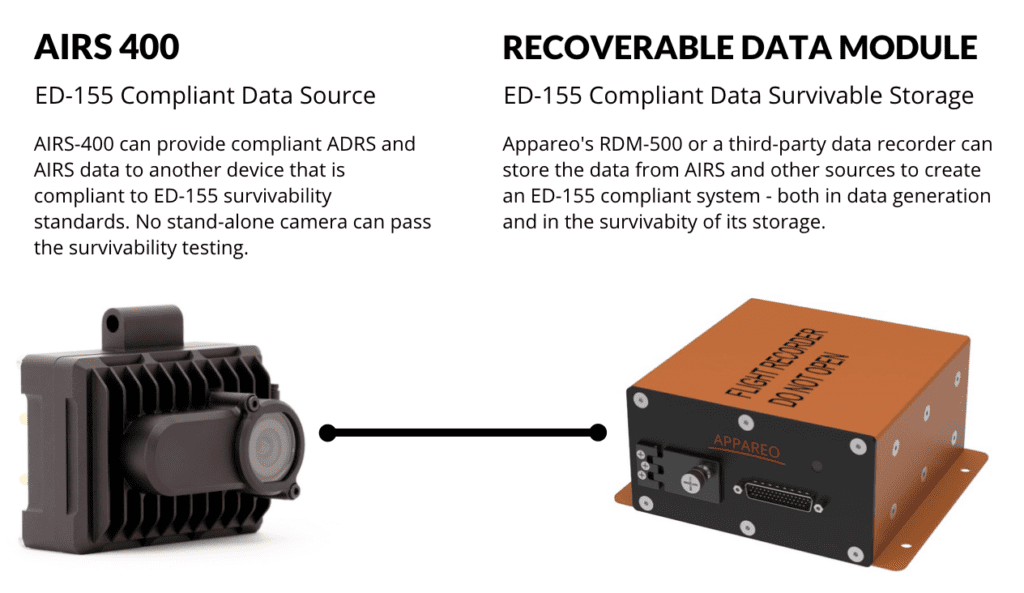
There are many different ways that AIRS-400, with its high survivability and alignment with ED-155 data acquisition/generation requirements, can help our global customers show compliance to regulations and standards that may invoke full or partial compliance to the ED-155 standard. The table below summarizes some of the ways in which this compliance can be achieved.
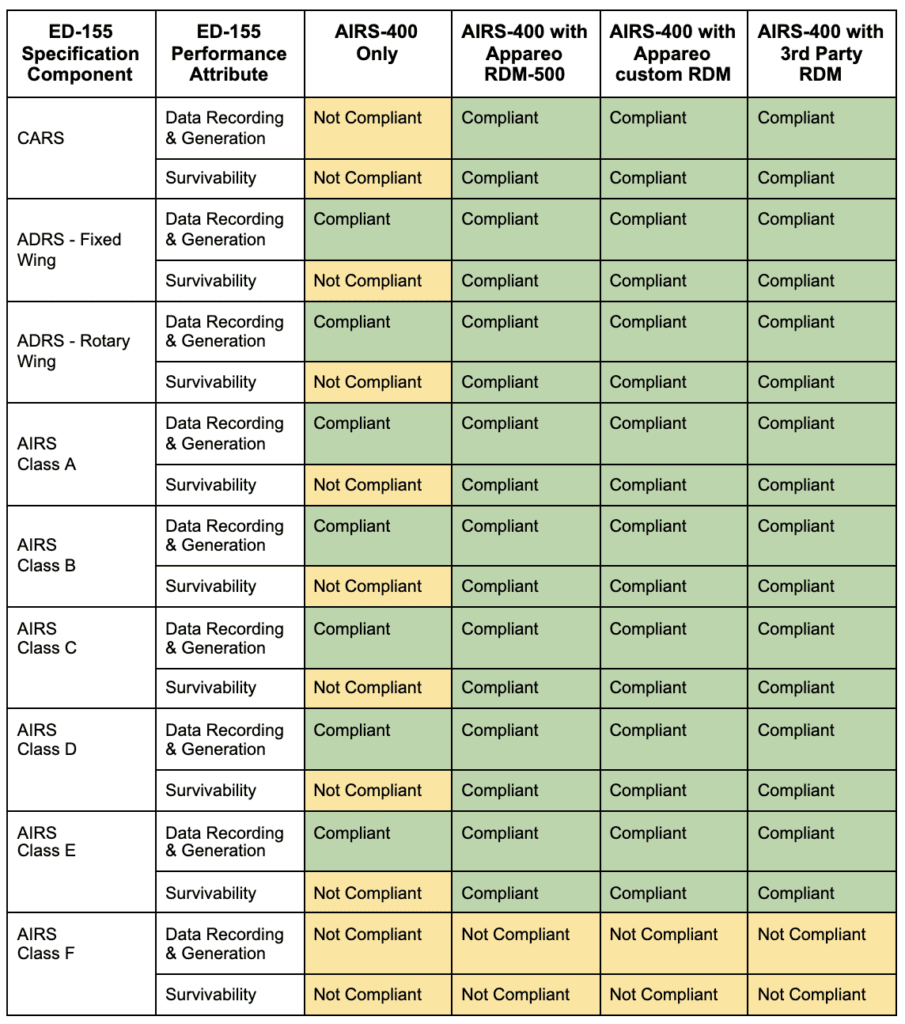
After reviewing this write-up and the above table, if you’re still trying to understand the standard, your requirements, and how to show compliance, please contact Appareo at [email protected].

David Batcheller
President & CBO
Lifesaving Technology
In the event the pilot of an airplane is unable to fly, Garmin Autoland can help protect the passengers on board by taking control of the airplane and landing it at a suitable airport. It’s revolutionary automation. And it’s the recipient of the 2020 Robert J. Collier Trophy — the annual award that represents the pinnacle of achievement in aeronautics and astronautics. In this special edition, we talk to Garmin engineers Bailey Scheel and Ben Patel and Executive Vice President, Managing Director of Aviation Phil Straub about the development of this technology — and what it means for the future of aviation.
The post Lifesaving Technology appeared first on Garmin Blog.
https://www.garmin.com/en-US/blog/aviation/lifesaving-technology/
The Flight to Perfection
Matthias Dolderer: flying instructor. Aerobatics legend. Air Race World Champion.
Cuban eight. Flick roll. Outside loop. When Matthias talks about aerobatics you can clearly hear his fascination for the sport. It’s his profession and his passion. For him, it has all the things he loves the most about flying as a pilot: speed, precision and skill.
“It’s the passion that gives you wings,” Matthias explains. “Plus, all the hard work I put in day after day, that is what helped me to launch my career. It all began at the local airfield when I was 5 years old. At the age of 10 I built my first model airplanes and four years later I took off for my first solo flight in a glider.” He remembers the emotions to this day and a hobby turned into a vocation. “I took part in an ultralight competition when I was 17 and won straight away. In addition to winning pride and passion, I felt that this is my future, my life.” He was a member of the national team at an early age, took part in European and World Championships and became Germany’s youngest flight instructor.
The combination of his passion for flying, obsession for perfection and being competitive from a young age made him fit perfectly into the world of air racing. A dream came true in 2009 when he took part in the Red Bull Air Race World Championship – the Formula 1 of the skies. “Only the best pilots qualify. I was ‘Best Rookie of the Year’. But even when you get there, you have to work hard every day, stay focused, learn from your setbacks and keep on improving.” The path to the winner’s rostrum was indeed long and hard, and it took a lot of resilience, determination and focus to get there. It all paid off in 2016, when he became the first and only German pilot ever to win this ultimate aviation sporting and speed spectacle. “It was amazing being one of the elite Air Race pilots, those madcap aviation enthusiasts, traveling the world, meeting new people and experiencing new cultures. Of course, the race itself is extreme. You have to fly your plane at speeds of up to 230 MPH just a few feet above the ground at the same time as navigating an obstacle course. It’s like trying to park a car in a garage at 250 MPH,” he laughs. “It isn’t just the adrenaline rush from flying at that speed that makes it so fascinating, but also the precision piloting of the plane. And you have to be in top mental and physical form.”

The Right Tool Watch
Technology obviously plays a crucial role in aviation. “When you’re in the air, you can still hear, see and feel. But sometimes the senses get confused. Especially when you’re upside down. That’s when I use the instruments for orientation. The plane’s look is also important to me. Both as a whole, and the details in the cockpit. That’s why my MARQ® Aviator is perfect for me. And it’s perfect in itself. Precision, perfection, design and style. It looks like an aircraft instrument. It’s kind of crazy how many things you can do with a tool watch these days: it gives me access to global aviator’s maps, it has a pre-flight check, routine check during the flight and even a direct-to navigation key and an off-course indicator. Pilots have an affinity with watches and to me the MARQ is the best fusion of aviation and everyday tools. In this way I can stay safe and efficient, and I have features like mails, alerts, Garmin Pay , etc. on my wrist.”
, etc. on my wrist.”
Like everyone else, Matthias has been longing to travel again. “With a bag over my shoulder and my MARQ Aviator on my wrist. An alarm at 4 a.m. in the morning. Still pitch black. Clear, cold and tangy air. Silence. Isolation. Start. Take-off. At one with nature and the skies. Then, the miracle of dawn. A pink hue over the horizon. The fascination of flying at its finest,” he concluded with a content smile.
To explore the full MARQ collection, click here.
The post The Flight to Perfection appeared first on Garmin Blog.
https://www.garmin.com/en-US/blog/aviation/the-flight-to-perfection/
What Is ED-155?
At Appareo we get A LOT of questions about ED-155. These questions are sometimes in reference to our recoverable data modules and other times in reference to our airborne image recorders.
What Is ED-155?
At a really high level, ED-155 is the minimum operational performance specification for a lightweight flight data recording system. The specification was created in response to industry pressure to provide lighter flight recorders as smaller aircraft were increasingly receiving pressure to carry flight recorders, but the predominant international flight recorder standard at the time (ED-112) was constructed primarily to address requirements for air carriers to have onboard cockpit flight and data recorders. The accident dynamics (where the crash occurs, how much energy is in the crash, what the potential for fire size/duration may be) are much different on large jetliners when compared to helicopters or smaller fixed-wing business aircraft. Especially with consideration for rotorcraft, weight and size are at a premium and lighter solutions that more appropriately address the survivability requirements of a recorder in a smaller aircraft accident were necessary to be created.
The specification was also created to encourage the modernization of flight data recording technologies, moving away from standards that support old recording media like magnetic tape.
How Is ED-155 Organized
The specification is constructed to cater to a variety of different data recording needs. It includes:
- Generals standards applicable to all recorder types
- Standards for Deployable Recorders
- A description of requirements that cater to different kinds of recorders, including:
- Cockpit Audio Recording Systems (CARS)
- Think of this as a cockpit voice recorder, although the specification also includes ambient audio data acquisition
- Aircraft Data Recording Systems (ADRS)
- Think of this as a flight data recorder
- Airborne Image Recording Systems (AIRS)
- Think of this as a cockpit camera
- Data-Link Recording Systems (DLRS)
- Think of this as a cockpit voice recorder but for digital data that is transmitted and received rather than cockpit voice
- Multi-Function Recording Systems
- Think of this as a system that combines two or more of the functions above
- Cockpit Audio Recording Systems (CARS)
The specification as a result provides a very comprehensive set of requirements that address almost any conceivable type of recording system.
Why This Can Be Confusing
This is confusing because there are no specific international mandates that decompose some of the five different categories of ED-155 and call on a specific subset of requirements to be compliant with a standard. Rather, the standard provides guidelines for a variety of different systems.
Tell Me About The General Standards
The general standards that address all recorder types include requirements for basic operation, safety, retention of recorded information, and survivability. The survivability standard covers requirements for impact/shock, crush, and flame survivability that are in excess of tests encountered in standards like RTCA DO-160. There is also a requirement that the survivable memory component of the flight recorder be bright orange and labeled with the words FLIGHT RECORDER in black letters.
What a Deployable Recorder Is And How It Relates
A deployable recorder is a recorder that is designed to come free from an aircraft in an accident sequence. In general, the objective of these recorders is often to pair them with a locating beacon and a means of flotation to allow the recorder to float and be recovered independently of the wreckage for incidents that occur over deep water. These recorders are typically mounted on the exterior of the aircraft. In Appareo’s experience, the smaller nature of the aircraft that are often under consideration for ED-155 recorders has made it unusual for us to encounter interest in deployable recorders of this size. Regardless, the standard provides for additional environmental and survivability testing criteria for ED-155 compliant recorders designed with this feature in mind.
What Is Considered A Cockpit Audio Recording System (CARS)
A CARS is a system that records both ambient area audio data (i.e. the noise inside the cockpit) as well as the pilot audio channel(s). The ambient area audio data allows accident investigators to listen to particulars of an incident, which can sometimes provide insights regarding aircraft mechanical failures (e.g. forensic analysis of turbine engine noise). The recording of pilot communications provides insights into pilot decision-making, communication between pilots, and interactions with air traffic control. In some recorder systems, the pilot audio channels and the cockpit area microphone data can be delivered by different system components.
The specification declares the performance and recording requirements (e.g. total recording capacity, recording delay tolerances, etc) for both the ambient and pilot sources while adding requirements or provisions for other capabilities (e.g. requiring a build erase function to be present). The standard also provides for the test requirements and procedures necessary to demonstrate a CARS’ performance against the standard’s requirements.
What is an Aircraft Data Recording System (ADRS)
An ADRS is a system that records digital flight data in an uncompressed format. The ED-155 standard allows for a variety of aircraft data sources, which is an effort to accommodate the wide variety of aircraft on which such recorders were intended to be installed. For example, acquiring flight data on helicopters that are not equipped with digital data buses as a portion of the avionic equipage may not be impractical – as a result, the standard allows for sensors interior to the ADRS to record such data (e.g. pitch/roll data from an IMU, GPS data, etc). Alternatively, a smaller aircraft used for business transport purposes may provide practical access to a digital data bus (e.g. ARINC 429) and the standard provides performance requirements for recording from such sources.
Much like the CARS, the ADRS specification declares performance and recording requirements for the ADRS while also specifying which parameters must be recorded, and at what frequency, for a unit to qualify as an ADRS.
What is an Aircraft Image Recording System (AIRS)
Aircraft image recording systems are equipment that is deployed for the intent of capturing image data regarding aircraft operation, which is typically then synchronized in time with the recording of other recorder types. For example, synchronizing AIRS with a CARS will provide synchronized playback of image and audio data from a flight. Likewise, synchronizing AIRS and ADRS can provide data to create synchronized cockpit videos with flight animations.
The AIRS systems are separated into six different classes. The classes are described by alpha characters (A through F) and are organized as follows:
- This Class provides a general image of the cockpit including instruments and a view of the external environment (through the glareshield)
- This Class provides a recording of the data-link message display
- This Class provides for a means of recording flight data where it is not possible or prohibitively expensive to otherwise do so
- This Class provides a means for capturing heads up displays
- This Class provides a means of capturing other camera images present to pilots (e.g. as a means of capturing cargo or cabin views presented to pilots)
- This Class provides means for capturing an external view of the aircraft
The standard provides guidance for operational considerations, like what portions of the cockpit to capture in the image frame and provisions for data security/privacy (e.g. preventing AIRS data from being easily played back by non-investigative personnel, as well as performance requirements in the areas of recording capacity, recording delay, and image compression.
What is a Data Link Recording Systems (DLRS)
Often when people refer to flight data recorders the physical interface between the flight data recorder and the aircraft is often done through ARINC 717. The objective of a DLRS is to record the messages passing to and from the aircraft via a digital means, which is typically accomplished using a standard avionic digital interface like ARINC429. In this manner, the DLRS is attempting to acquire information like data exchanged through CPDLC, digital ATIS, NOTAM delivery, etc.
Although Appareo’s recording solutions (both AIRS and RDM) can support acquiring DLRS data we typically don’t list such recorders in our compliance tables because the FANS, CPDLC, and related on-aircraft features that necessitate and enable such recorders don’t typically appear in aircraft under consideration for ED-155 style, lighter, flight data recorders.
How does AIRS-400 Comply with ED-155?
AIRS can do all of the data acquisition and recording to show compliance to a variety of ED-155 requirements by itself, however, to show full compliance to the standard the camera needs to be hooked up to another module. This section of the document will further discuss why a second module MAY be required for some installations. For the overwhelming majority of AIRS installations a second module is not required because the AIRS cameras are:
- Capable of surviving most aircraft accidents without one; and,
- In most of the world, there is no regulatory requirement to specifically be equipped with such a recorder
The sections below discuss the ways in which the AIRS-400 is not compliant with the ED-155 standard and discuss why those noncompliances exist. Then, finally, a table will provide the combinations of AIRS-400 and other products that can be used to show full compliance to the ED-155 standard.
ED-155 | Non-Compliant Appearance
AIRS-400, in an off-the-shelf configuration, is not compliant with ED-155 section 2-1.14.4. This portion of the standard requires that the recorder be bright orange in color with black letters that say, “FLIGHT RECORDER.” In general, Appareo finds our customers to prefer a less obvious, intrusive, color for a product mounted within the cockpit in plain sight. It would be possible to create a variant of our AIRS that would be bright and orange and marked in this manner, but in general, Appareo finds that our customers do not want the camera marked in such a manner because they believe it looks bad in the cockpit.
ED-155 | Non-compliant Survivability
In general, the AIRS-400 is significantly more survivable than our previous cockpit camera product, the Vision 1000. The product is not, however, compliant with ED-155 section 2-4.2.4.
It is not compliant with this portion of the standard because compliance with the flame survivability requirement requires the presence of a phase change material, a material that is used to absorb the heat energy in the event of a fire. The mass of phase change material that is necessary to absorb the amount of heat energy products are subjected to in this test is roughly 4 times the volume, and 4 times the weight, of Appareo’s AIRS-400 product. This creates a large, unattractive, product package for mounting into the ceiling of a cockpit or flight deck. For a customer that requires ED-155 or ED-112 flame survivability, a recoverable memory module mounted in a more convenient location for a large, heavy product is the right architecture for the deployment of a flight data recording system. This provides the optimal flight data acquisition capability, with a visually attractive and high-performing camera solution providing digital data to a large, less attractive, recoverable module buried out of sight in the aircraft.
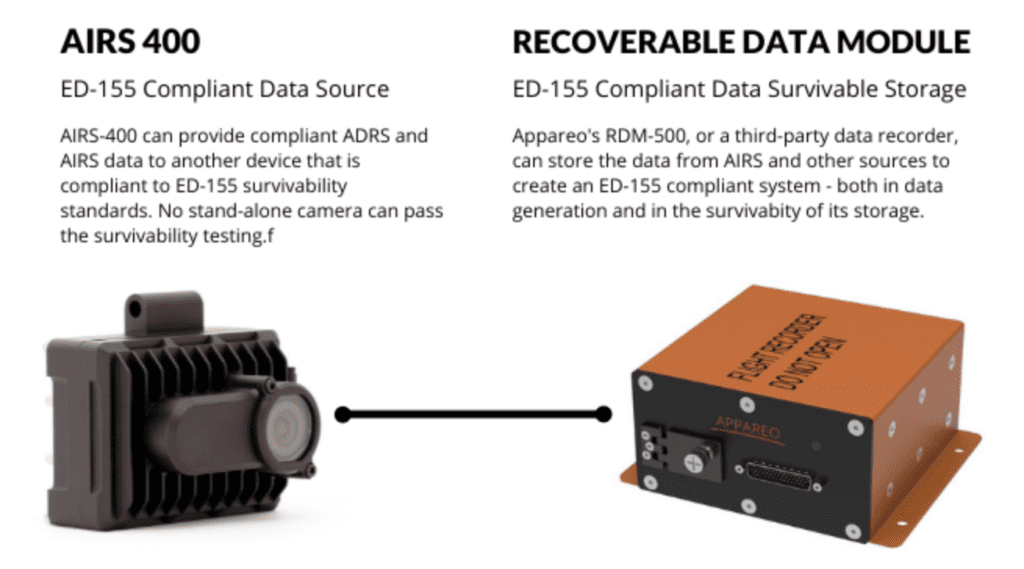
ED-155 | Achieving Full Compliance Using Appareo’s New Recorder
Achieving full compliance with ED-155 is possible with AIRS-400 in a number of ways. The first, and perhaps easiest, is to connect the camera to a recoverable memory module of either Appareo or third-party manufacture. For example:
- AIRS-400 could be used to generate data on an analog aircraft, using its internal sensors, and send that data to a large orange flight recorder (which may have no internal sensors, and on an aircraft with limited or no digital instrumentation) to provide the ED-155 ADRS function needed to comply with ED-155, refer to TSO-C197
- AIRS-400 could be used to acquire image data and send that data to a large orange flight recorder to satisfy both the AIRS and ADRS requirement on a modern, digital, aircraft that are not factory equipped with a cockpit/flight deck image recorder
- AIRS-400 could be used to provide ADRS data and the ambient area microphone function to a large orange flight recorder that provides CVFDR functionality on an aircraft with primarily analog instrumentation, greatly simplifying that recording system’s deployment
- Et cetera
There are many different ways in which this new camera, with its high survivability and alignment with ED-155 data acquisition/generation requirements, can help our global customers show compliance to regulations and standards that may invoke full or partial compliance to the ED-155 standard. The table below helps summarize some of the ways in which this compliance can be achieved.
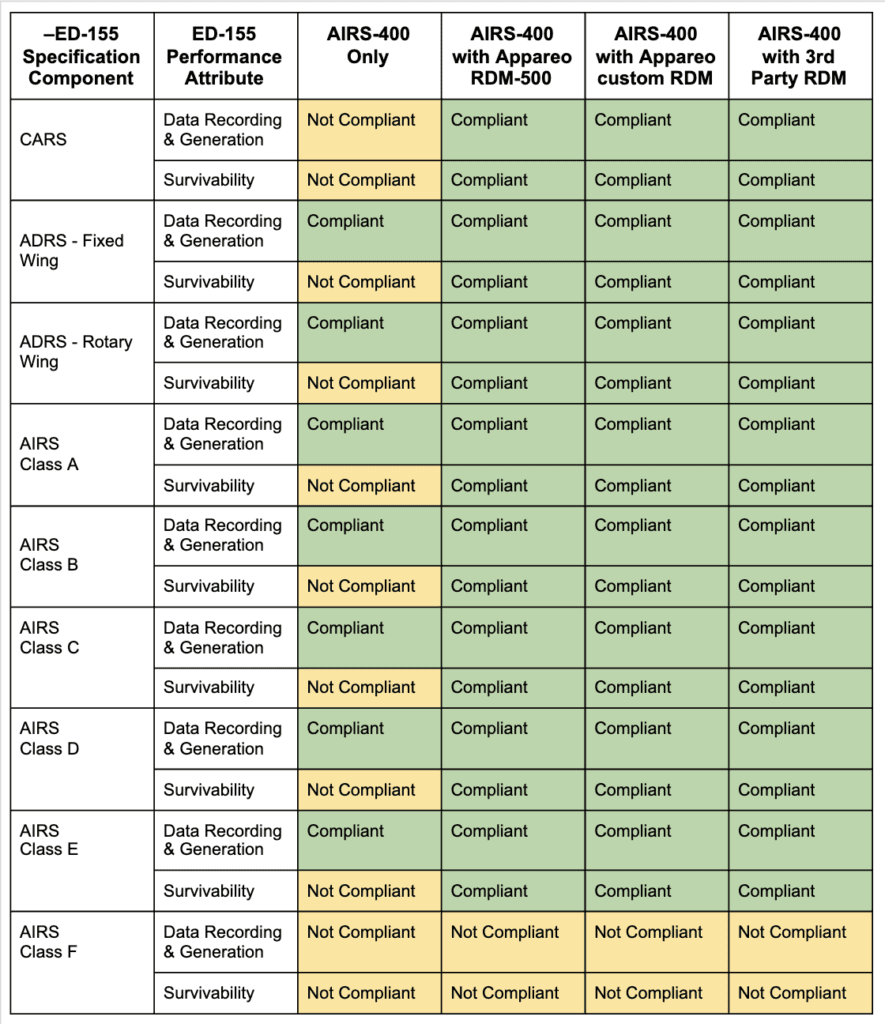
If, after reviewing this write-up and the above table, you’re still trying to understand the standard, your requirements, and how to show compliance, please contact Appareo.
Part of our role in helping our customers to be successful is providing transparent, direct, assistance in navigating these standards to achieve an affordable and conveniently implemented system that truly fits the aircraft while showing compliance to required regulations.

David Batcheller
President & CBO https://appareo.com/2021/08/09/what-is-ed-155/
Understanding ED-155: What you need to know about specifications and guidelines
At Appareo we get a lot of questions about ED-155. These questions are sometimes in reference to our recoverable data modules and other times in reference to our airborne image recording systems.
ED-155 is the minimum operational performance specification for a lightweight flight data recording system. The specification was created in response to industry pressure to provide lighter flight recorders as smaller aircraft were increasingly receiving pressure to carry flight recorders. ED-155 was also created to encourage modernization of flight data recording technologies, moving away from standards that support old recording media like magnetic tape.
In this article we will talk about:
- General standards
- Standards for Deployable Recorders; and
- Requirements that cater to different kinds of recording systems, including:
-
- Cockpit Audio Recording Systems (CARS) – a cockpit voice recorder, with ambient audio data acquisition
- Aircraft Data Recording Systems (ADRS) – a flight data recorder
- Airborne Image Recording Systems (AIRS) – a cockpit camera
- Data-Link Recording Systems (DLRS) – a cockpit voice recorder but for digital data rather than cockpit voice
General Standards
The general standards that address all recorder types include requirements for basic operation, safety, retention of recorded information, and survivability. The survivability standard covers requirements for impact/shock, crush, and flame survivability that are in excess of tests encountered in standards like RTCA DO-160. There is also a requirement that the survivable memory component of the flight recorder be bright orange and labeled with the words “FLIGHT RECORDER” in black letters.
Standards for Deployable Recorders
A deployable recorder is a recorder that is designed to come free from an aircraft in an accident sequence. In general, the objective of these recorders is often to pair them with a locating beacon and a means of flotation to allow the recorder to float and be recovered independent of the wreckage for incidents that occur over deep water. These recorders are typically mounted on the exterior of the aircraft. In Appareo’s experience, the smaller nature of the aircraft that are often under consideration for ED-155 recorders has made it unusual for us to encounter interest in deployable recorders of this size. Regardless, the standard provides for additional environmental and survivability testing criteria for ED-155 compliant recorders designed with this feature in mind.
Four System Categories
ED-155 specification provides a very comprehensive set of requirements that address almost any conceivable type of recording system. This may be confusing because there are no specific international mandates that decompose the five different categories of ED-155 and call on a specific subset of requirements to be compliant with a standard. Rather, the standard provides guidelines for a variety of different systems.
1. Cockpit Audio Recording Systems (CARS)
CARS is a system that records both ambient area audio data (i.e. the noise inside the cockpit) as well as the pilot audio channel(s). The ambient area audio data allows accident investigators to listen to particulars of an incident, which can sometimes provide insights regarding aircraft mechanical failures (e.g. forensic analysis of turbine engine noise). The recording of pilot communications provides insights into pilot decision-making, communication between pilots, and interactions with air traffic control. In some recorder systems, the pilot audio channels and the cockpit area microphone data can be delivered by different system components.
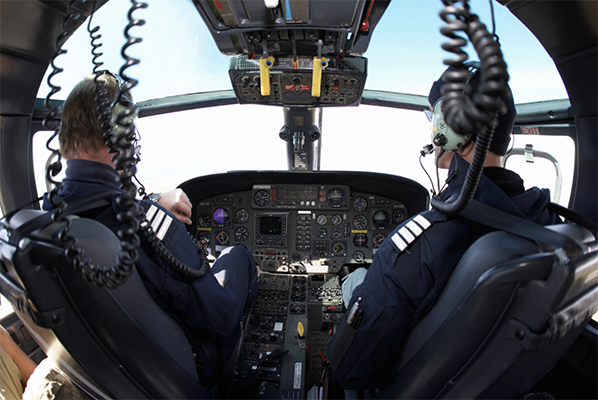
The specification declares the performance and recording requirements (e.g. total recording capacity, recording delay tolerances, etc) for both the ambient and pilot sources, while adding requirements or provisions for other capabilities (e.g. requiring a build erase function to be present). The standard also provides for the test requirements and procedures necessary to demonstrate a CARS’ performance against the standard’s requirements.
2. Aircraft Data Recording System (ADRS)
ADRS is a system that records digital flight data in an uncompressed format. The ED-155 standard allows for a variety of aircraft data sources, which is an effort to accommodate the wide variety of aircraft on which such recorders were intended to be installed. For example, acquiring flight data on helicopters that are not equipped with digital data buses as a portion of the avionic equipage may not be impractical – as a result the standard allows for sensors interior to the ADRS to record such data (e.g. pitch/roll data from an IMU, GPS data, etc). Alternatively, a smaller aircraft used for business transport purposes may provide practical access to a digital data bus (e.g. ARINC 429) and the standard provides performance requirements for recording from such sources.
Much like the CARS, the ADRS specification declares performance and recording requirements for the ADRS while also specifying which parameters must be recorded, and at what frequency, for a unit to qualify as an ADRS.
3. Aircraft Image Recording System (AIRS)
AIRS equipment is deployed for the intent of capturing image data regarding aircraft operation, which is typically then synchronized in time with the recording of other recorder types. For example, synchronizing AIRS with a CARS will provide a synchronized playback of image and audio data from a flight. Likewise, synchronizing AIRS and ADRS can provide data to create synchronized cockpit video with flight animations.
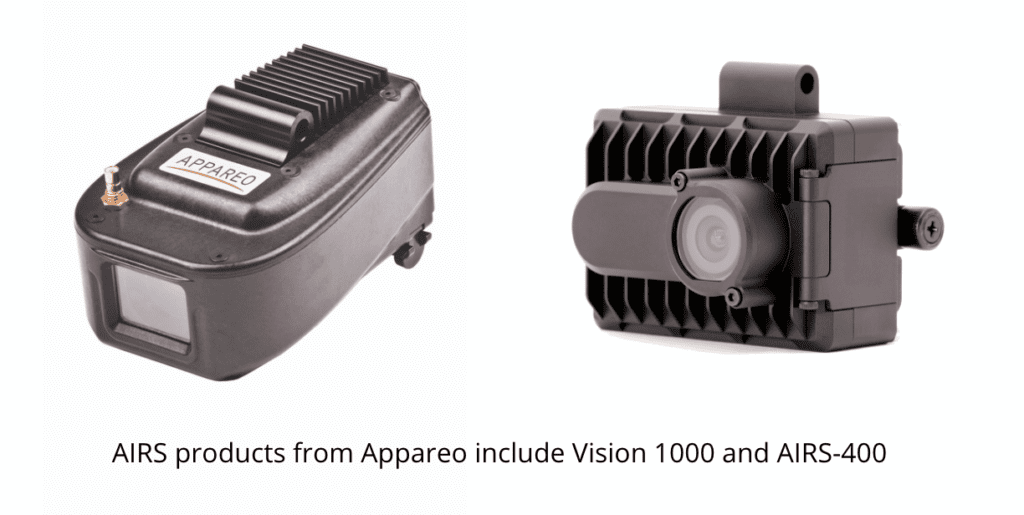
AIRS systems are separated into six different classes. The classes are described by alpha characters (A through F) and are organized as following:
Class A provides a general image of the cockpit including instruments and a view of external environment (through the glareshield).
Class B provides a recording of the data-link message display.
Class C provides for a means of recording flight data where it is not possible or prohibitively expensive to otherwise do so.
Class D provides a means for capturing heads up displays.
Class E provides a means of capturing other camera images present to pilots (e.g. as a means of capturing cargo or cabin views presented to pilots).
Class F provides means for capturing an external view of the aircraft.
The standard provides guidance for operational considerations, like what portions of the cockpit to capture in the image frame and provisions for data security/privacy (e.g. preventing AIRS data from being easily played back by non-investigative personnel, as well as performance requirements in the areas of recording capacity, recording delay, and image compression.
4. Data Link Recording Systems (DLRS)
Often when people refer to flight data recorders the physical interface between the flight data recorder and the aircraft is often done through ARINC 717. The objective of a DLRS is to record the messages passing to and from the aircraft via digital means, which is typically accomplished using a standard avionic digital interface like ARINC 429. In this manner, the DLRS is attempting to acquire information like data exchanged through CPDLC, digital ATIS, NOTAM delivery, etc.
If you’re still trying to understand ED-155, your requirements, and how to show compliance, please contact Appareo at sales@appareo.com.
To learn how Appareo’s AIRS-400 can comply with ED-155, click here.
 David Batcheller
David Batcheller
President & CBO
https://appareobeta.flywheelsites.com/2021/08/09/what-is-ed-155/

